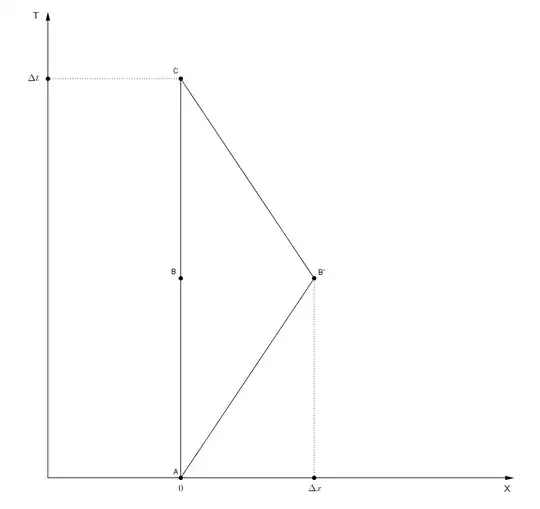I've very recently started to try to understand special relativity. I'm want to get a decent understanding of the twin paradox. I'll post what I've done so far and highlight what's gone wrong for me.
The situation is that Alice and Bob both begin at point $x_1$ in Alice's coordinate system $(x,t)$ (we have orientated the axis so that y and z will not matter). Bob then instantaneously moves off with velocity $v$ in the positive $x$ direction. Bob's coordinate system is now $(x',t')=(\gamma (x-vt), \gamma (t-v\frac{x}{c^2}))$. In Alice's coordinates, Bob reaches point $x_2$ after having moved distance $d$, then instantly turns around and travels back to Alice at $-v$. I want to show that Alice's space time interval $\Delta s_A^2$ is greater than Bob's $\Delta s_B^2$, as each path's space time interval is proportional to the proper time passed along that path.
According to Alice: $\Delta s_A^2=-c^2\Delta t^2 + \Delta x_A^2$ where $\Delta t=\dfrac{2d}{v}$ and $\Delta x_A=0$ as she didn't move, but the time elapsed is the time it took bob to travel the distance and then come back. Thus $\Delta s_A^2=-\dfrac{4c^2d^2}{v^2}$
Still according to Alice, Bob's $\Delta s_B^2=-c^2\Delta t^2+\Delta x_B^2$, where the change in time is the same, but now bob has moved distance $d$ twice, thus $\Delta x_B=2d$ ($\Delta x$ refers to total distance traveled rather than displacement which is 0 in this case). Now we have $\Delta s_B^2=-\dfrac{4c^2d^2}{v^2}+4d^2$.
The |size| of Bob's spacetime interval now definitely smaller than Alice's, and this would be all OK, except that when I do the calculations in Bob's frame, they don't agree. This is contradictory to the fact that $\Delta s^2$ is conserved under Lorentz transformations.
According to Bob: $\Delta {s'}_A^2=-c^2\Delta t'^2 + \Delta {x'}_A^2$ where $\Delta t'=\dfrac{2d'}{v}$. I'm not sure if I'm right in saying that $v$, the relative velocity of the two frames, is the only velocity upon which both Alice and Bob will agree on, other than the speed of light. Anyway, $d=\gamma d'$ as lengths contract by $\gamma$ i.e. $d'$ is smaller than $d$ by factor $\gamma$. Also, $\Delta {x'}_A=2d'$, so we have $\Delta {s'}_A^2=-\dfrac{4c^2d'^2}{v^2}+4d'^2=-\dfrac{4c^2d^2}{\gamma ^2 v^2}+\dfrac{4d^2}{\gamma ^2}=4d^2\dfrac{v^2-c^2}{\gamma^2 v^2}\neq \Delta s_A^2$
Although I haven't included them here, my calculations for $\Delta {s'}_B^2$ and $\Delta s_B^2$ agree. Sorry for the ultra-long post, but any help would we well appreciated!
